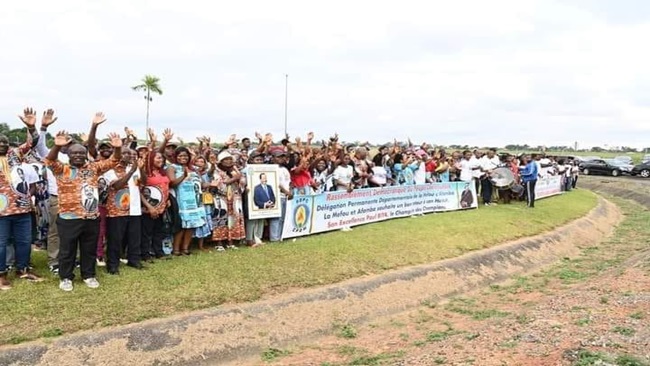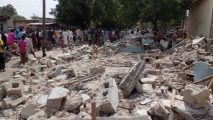25, March 2019
Disease fears mount for Southern Africa cyclone survivors 0
Disease is threatening to aggravate the already dire conditions facing millions of survivors following the powerful tropical cyclone that ravaged southern Africa 10 days ago, officials warned on Sunday.
Cyclone Idai smashed into Mozambique’s coast unleashing hurricane-force wind and rain that flooded swathes of the poor country before battering eastern Zimbabwe — killing 705 people across the two nations.
“It is inevitable that cases of cholera and malaria will arise. In many areas we are already fighting with malaria cases,” said Land Minister Celso Correia at a briefing in Beira, 1,000 kilometers northeast of the capital, Maputo.
The UN Office for the Coordination of Humanitarian Affairs’ Sebastian Rhodes Stampa, also at the briefing, warned that disease outbreaks in inaccessible areas could be “really problematic.”
The World Food Programme said Friday that the humanitarian disaster unfolding in Mozambique is on a par with the situation in Yemen and Syria.
Aid workers from across the world are continuing to arrive in the region to bring help to more than two million affected people across an area of roughly 3,000 square kilometers.
Survivors are struggling in desperate conditions with some still trapped on rooftops and those rescued in urgent need of food and medical supplies.
“The government is already setting up a cholera treatment center to mitigate cholera. We should not be frightened when cholera issues arise,” added Correia, describing efforts to control the emerging humanitarian crisis. “It is normal. It’s almost inevitable. Malaria, we know how it arises. We have lots of wetlands and we’re going to have malaria that is sure to come up (there).”

Wilfried Deloviare, a 19-year-old resident of Beira, which was caught in the eye of the storm, said he felt “sorry for our town, our city, because we suffered a lot to build it.”
“Houses are completely destroyed, and some people don’t have money to rebuild their businesses — and many businesses are going to fail,” he told AFP.
‘People don’t know what to do’
More than two million people have been affected in Mozambique, Zimbabwe, and Malawi, where the storm started as a tropical depression causing flooding, which killed 60 and displaced nearly a million people. Hundreds are still missing in Mozambique and Zimbabwe.
The International Committee of the Red Cross said it had recorded two cases of cholera so far but the UN was unable to confirm the reports.
Stampa described efforts to re-open the main access road to Beira as a “big victory.”
“We will be able to bring more help to families living in this affected area,” he said.
Those living in affected areas of Mozambique began to trickle back to church over the weekend.
The Ponta Gea Catholic Cathedral in Beira was miraculously undamaged by the storm while the church next door was leveled.
“The people don’t know what to do because they lost their houses, they have no food, they don’t know where to sleep — this brings sadness and anxiety,” said Father Pedro, who conducted a mass in darkness late on Saturday.
Much of the area hit by the cyclone remains disconnected from electricity supplies, complicating rescue efforts at nightfall.
As many as 109,000 people are living in shelters across central Mozambique, many of them located in and around Beira.
One survivor was six-year-old Elena Joaquin, who clutched a coconut as she sat surrounded by pots and pans at a shelter in Buzi, southwest of Beria, where she had sought refuge along with her parents.
But life had slowly begun to return to normal in central Beira, where traffic was flowing more than in recent days and businesses were resuming trade.
(Source: AFP)




























25, March 2019
Côte d’Ivoire: A beacon of hope 0
While many people across the globe hold that French-speaking countries in Africa may never make giant economic development strides because of their affinity to France, Côte d’Ivoire is debunking that myth one project at a time. The country that many had written off in the mid-nineties due to its political conflict is gradually positioning itself as a leader in the West African sub-region.
Sound policies and commitment to reforms have helped the country secure good terms on its Eurobonds issued in 2017 and 2018. External public debt is projected to reach nearly 30 percent of GDP in 2018 and is currently assessed to be sustainable in the medium-term. However, higher reliance on international market financing may raise rollover risks and reduce policy space to buffer future shocks.
Over the last six years, this West African country has undertaken major development projects and infrastructure development seems to be the government’s focus. The government is currently working with the private sector to modernize the country’s infrastructure and this has caught the attention of foreign investors who want to be part of this success story that is being written with a golden pen and which is making the country a beacon of hope.
The government is working on improving market access for crops by upgrading transportation infrastructure, extending electricity provision, and developing strategies to enhance value-added from cocoa and cashews.
Today, the country’s capital, Abidjan, has become a vast construction site with storey buildings popping up like mushroom in all the city’s neighborhoods. Côte d’Ivoire has made significant progress in reducing processing time for building permits and has introduced a new system for electronic payment of taxes and a credit bureau. There is scope for catching up with sub-Saharan African frontier market countries by improving credit access through stronger legal rights for borrowers and creditors and deeper credit information on borrowers.
Foreign capital is heading to Cote d’Ivoire and the government’s determination to place the country on the map as the most modern in West Africa is paying off big time. Even international organizations are noticing the efforts by the country’s government and their reports on the country are boosting the country’s image.
According to the African Development Bank (AfDB) Group, the country’s macro-economic performance has been encouraging. The continent’s leading development finance institution reported that despite many and major economic challenges in 2018, the country’s real GDP growth reached an estimated 7.4% in 2018, down from 7.7% in 2017, supported by external demand for agricultural and oil products and stronger domestic demand resulting from major investment projects and households consumption.
The AfDB report points out that the country’s economy faced several shocks in 2017, including a sharp decline in cocoa prices, higher oil prices, and social tensions. As a result, the budget deficit increased to 4.2% of GDP, but it improved to an estimated 3.8% in 2018. Public debt increased to 48.2% of GDP in 2018, driven by Eurobond issuances in 2017 and 2018. The risk of debt distress remains moderate. Inflation was low, at an estimated 0.5% in 2018, down from 1.0% in 2017. The current account deficit widened to an estimated 2.7% of GDP in 2018 from 1.8% in 2017.
The AfDB holds that the country’s economic outlook remains favorable, with real GDP growth projected at 7.0% in 2019 and 6.9% in 2020. A good performance in the agricultural sector will keep inflation below the 3% convergence threshold for the West African Economic and Monetary Union (WAEMU). The current account deficit is projected to stabilize at 2.8% in 2019, in connection with sustained imports of capital goods related to infrastructure projects.
The economy remains vulnerable to external shocks that may stem from unfavorable evolution of commodity prices (mainly cocoa and oil) and adverse climate conditions. Another pressing challenge is to sustain economic growth and ensure a more balanced distribution across sectors, with a view to achieving a structural transformation of the economy. This would require improving the quality of agricultural products and upgrading the industrial sector toward higher value added and high–job creation activities.
Regarding reforms, Côte d’Ivoire has implemented many reforms as part of its 2016–2020 National Development Plan. In energy, reforms have focused on ensuring the sector’s financial sustainability, clearing arrears for independent producers, and investing in supply capacity. As a result, installed capacity increased by 56% between 2011 and 2018 to 2,200 MW. Rural electricity coverage has also expanded from 33% of the rural population to 54%. In agriculture, reforms have focused on accelerating the development of value chains and increasing local processing for major agricultural products, including cocoa, cashew nuts, palm oil, and rubber. Investment has also improved the quality of and access to basic education and health services. But poverty and inequality reduction remain a challenge.
Côte d’Ivoire is party to most of the relevant continental institutions dedicated to regional integration. The country has historically been an important destination for immigration and remains at the center of one of the continent’s most dynamic migration routes. Côte d’Ivoire is also an important transit corridor for its landlocked neighbors, thanks to its ports in Abidjan and San Pedro. It is a key partner in the regional electricity market and is part of an electricity interconnection network with Benin, Burkina Faso, Ghana, Togo, and soon Mali, as well as to the Mano River Union countries (Guinea, Liberia, and Sierra Leone). Côte d’Ivoire is the major player in WAEMU’s financial markets and hosts the regional securities exchange. Côte d’Ivoire has also increased investment in regional energy, road, and air infrastructure and telecommunication networks.
For the seventh consecutive year, the country’s economic growth was projected to exceed 7% and reach 7.4% in 2018, despite the country’s vulnerability to external shocks and political uncertainty in the run up to the presidential elections in 2020. This was the verdict of the Eighth Economic Update for Côte d’Ivoire published today by the World Bank. The country, therefore, continues to have one of the most dynamic economies in the world, boasting the highest growth rates in the West African Economic and Monetary Union (WAEMU), despite a slight drop of 0.3% in relation to its performance in 2017 (7.7%).
According to a World Bank report entitled “Que la route soit bonne, améliorer la mobilité urbaine à Abidjan,”the country has witnessed some decline because of the fact that the public and external sectors have been less supportive of growth and the contribution of the private sector has been more uneven.
The short- and medium-term outlook however remains favorable. The growth rate over the next few years is expected to be roughly 7%, provided that the global environment remains fairly stable and the Government continues its efforts to promote the private sector and foster more inclusive growth.
The report also devotes an entire section to the challenges of urban mobility in this country where the rate of urbanization soared from 17.7% in 1960 to over 50% in 2018. Today, 80% of economic activity in the country is concentrated in Abidjan, the economic capital of Côte d’Ivoire and home to over 5 million people.
“Urbanization, once it is well planned and managed, can help the country’s businesses become more productive and improve households’ living conditions by offering them jobs, schools for their children, and better health care than in rural areas,” explains Jacques Morisset, World Bank Program Leader in Côte d’Ivoire and lead author of the report.
Given that by 2050, nearly two out of three Ivorians will be living in an urban center, over 10 million of whom will settle in Abidjan, urban mobility challenges will intensify if no action is taken, and solutions will become increasingly difficult to implement. The report analyzes the daily mobility constraints faced by commuters and proposes several avenues for improving urban transport and ensuring the success of the Greater Abidjan project adopted in 2016.
“There are approximately 10 million trips taken every day in Abidjan and each household spends close to CFAF 1075 (about US$1.80) and loses over three hours a day in commuting time,” explains Anne Cecile Souhaid, Senior Transport Specialist and co-author of the report. “That is equivalent to nearly 5% of the national GDP in 2017. However, a 20% improvement in urban mobility in Abidjan could generate gains of almost 1% of annual GDP growth.”
Since achieving independence in 1960, Côte d’Ivoire has managed to maintain broadly friendly relations with its neighbours, its French former colonial ruler, and within a continental and multilateral context. Côte d’Ivoire has long been a player in ECOWAS, which ties the country to 14 other nations in the region. Eight countries also share membership of the West African CFA franc zone, the central bank of which is headquartered in Abidjan.
Recently, after a decade-long political crisis ended in 2011, Côte d’Ivoire’s economy has bounced back to become one of the fastest-growing in Africa. Between 2012 and 2016 the country’s GDP grew by an annual average of 9%, with the IMF forecasting annual GDP expansion of at least 6.5% through to 2023. This recovery was supported by rising international commodity prices, as well as substantial public sector funding to rebuild and upgrade infrastructure that had suffered from years of under-investment. At the same time, the country has sought to diversify its agriculture-focused economy by developing the mining and oil and gas sectors.
The IMF recently completed its annual health check of the Ivoirian economy. Political normalization and good implementation of reforms have contributed to the country’s strong economic performance since 2012. Going forward, bold structural reforms are needed to sustain the pace of development, and ensure that the benefits are shared by all. The current government is committed to keeping the economy dynamic while ensuring that growth is shared and pro-poor.
By Bamba Gaoussou
Cameroon Concord News Group correspondent in Abidjan